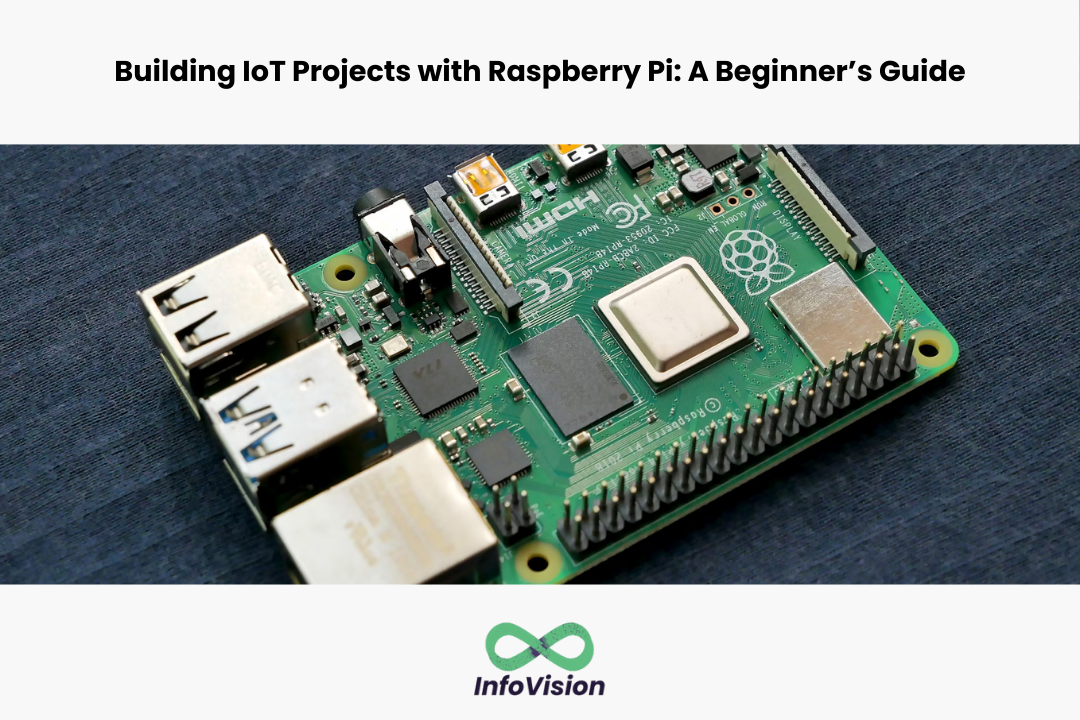Building IoT Projects with Raspberry Pi: A Beginner’s Guide
Building IoT Projects with Raspberry Pi: A Beginner’s Guide
Raspberry Pi is a small, affordable, and versatile computer that is ideal for building IoT projects. With its GPIO pins, Wi-Fi connectivity, and powerful processing capabilities, Raspberry Pi can be used to create a wide range of IoT devices, from smart home appliances to industrial monitoring systems. However, for beginners, the prospect of building an IoT project can be daunting.
This beginner’s guide aims to provide a comprehensive introduction to building IoT projects with Raspberry Pi. It will cover the basics of IoT, including sensors, actuators, and cloud computing, and explain how to use Raspberry Pi to build simple and complex IoT systems. The guide will also provide step-by-step instructions for setting up Raspberry Pi, installing the necessary software, and connecting to the cloud.
Whether you are a hobbyist, a student, or a professional, this guide will equip you with the knowledge and skills you need to get started with building IoT projects using Raspberry Pi. With its user-friendly interface, affordable price, and vast community support, Raspberry Pi is the perfect platform for exploring the exciting world of IoT.
Getting Started with Raspberry Pi
Raspberry Pi is a single-board computer that can be used for a variety of projects, including IoT projects. In this section, we will cover the basics of getting started with Raspberry Pi.
Choosing the Right Raspberry Pi Model
There are several Raspberry Pi models available, each with different features and capabilities. The most popular models for IoT projects are the Raspberry Pi 3 and Raspberry Pi 4.
The Raspberry Pi 3 Model B+ is a popular choice for beginners. It has a 1.4GHz quad-core processor, 1GB of RAM, and built-in Wi-Fi and Bluetooth. It also has a variety of ports, including four USB 2.0 ports, a full-size HDMI port, and a 3.5mm audio jack.
The Raspberry Pi 4 Model B is a more powerful option, with a 1.5GHz quad-core processor, up to 8GB of RAM, and support for dual 4K displays. It also has two USB 3.0 ports, two USB 2.0 ports, and two micro-HDMI ports.
When choosing a Raspberry Pi model, consider your project requirements and budget.
Setting Up Your Raspberry Pi
Once you have chosen a Raspberry Pi model, the next step is to set it up. Here are the basic steps:
- Download the Raspberry Pi operating system (OS) from the official website.
- Flash the OS onto a microSD card using a tool like Etcher.
- Insert the microSD card into the Raspberry Pi.
- Connect a keyboard, mouse, and monitor to the Raspberry Pi.
- Power on the Raspberry Pi using a USB power supply.
After the Raspberry Pi boots up, you will need to configure the OS and install any necessary software. This process will vary depending on your project requirements.
In summary, getting started with Raspberry Pi is relatively easy. Choose the right model for your project, set it up, and start building your IoT project.
Understanding IoT Fundamentals
What is IoT?
IoT (Internet of Things) is a network of physical devices that are connected to the internet and can communicate with each other. These devices can be anything from smart thermostats, security cameras, and even home appliances like refrigerators and washing machines. The purpose of IoT is to make everyday tasks easier and more efficient by allowing devices to communicate with each other and exchange data.
How Raspberry Pi Fits into IoT
Raspberry Pi is a small, affordable, and powerful computer that can be used to build IoT projects. It has built-in Wi-Fi and Bluetooth capabilities, making it easy to connect to the internet and communicate with other devices. Raspberry Pi can also be used to control sensors and actuators, which are essential components in many IoT projects.
One of the main advantages of using Raspberry Pi for IoT projects is its flexibility. It can run a variety of operating systems, including Raspbian, which is a version of Debian Linux specifically designed for Raspberry Pi. This means that developers can use a wide range of programming languages and tools to build IoT applications.
In addition, Raspberry Pi has a large community of developers and enthusiasts who share their knowledge and projects online. This makes it easy for beginners to get started with IoT and learn from others who have already built successful projects.
Overall, Raspberry Pi is an excellent platform for building IoT projects, and its versatility and affordability make it an ideal choice for beginners who want to explore the world of IoT.
Exploring IoT Communication Protocols
When it comes to building IoT projects with Raspberry Pi, communication protocols play a vital role in connecting devices and exchanging data. Here are some of the most popular IoT communication protocols that you can use with Raspberry Pi.
Bluetooth and BLE
Bluetooth and Bluetooth Low Energy (BLE) are wireless communication protocols that allow devices to connect and communicate with each other over short distances. They are commonly used in IoT projects that involve wearable devices, smart home appliances, and health monitoring systems.
With Raspberry Pi, you can use the built-in Bluetooth module to connect to other devices and exchange data. BLE is particularly useful for low-power IoT devices that require long battery life.
Wi-Fi and MQTT
Wi-Fi is a popular wireless communication protocol that allows devices to connect to the internet and exchange data. It is commonly used in IoT projects that involve remote monitoring, smart home automation, and industrial automation.
With Raspberry Pi, you can use the built-in Wi-Fi module to connect to the internet and exchange data with other devices. MQTT (Message Queuing Telemetry Transport) is a lightweight messaging protocol that is commonly used in IoT projects to exchange data between devices over Wi-Fi.
ZigBee and Z-Wave
ZigBee and Z-Wave are wireless communication protocols that are commonly used in IoT projects that involve home automation and smart energy management. They are designed to be low-power and low-data-rate protocols, making them ideal for IoT devices that require long battery life and low bandwidth.
With Raspberry Pi, you can use ZigBee and Z-Wave modules to connect to other devices and exchange data. These protocols are particularly useful for IoT projects that involve smart lighting, temperature control, and security systems.
In summary, there are many IoT communication protocols available that can be used with Raspberry Pi. Choosing the right protocol depends on the specific requirements of your project. By understanding the strengths and weaknesses of each protocol, you can make an informed decision and build a successful IoT project with Raspberry Pi.
Designing IoT Projects
When designing IoT projects, it is important to consider the project lifecycle and user experience.
Project Lifecycle
The project lifecycle of an IoT project includes the following stages: planning, design, development, testing, deployment, and maintenance. Each stage is important to ensure the success of the project.
In the planning stage, it is important to define the goals and objectives of the project. This includes identifying the problem that the project is trying to solve, determining the target audience, and setting project timelines and budgets.
During the design stage, the project team should create a detailed plan for the project. This includes creating a project roadmap, defining the architecture of the system, and identifying any necessary hardware and software components.
The development stage involves building the project according to the design plan. This includes coding the software, assembling the hardware, and integrating the various components of the system.
Testing is an important stage to ensure that the project works as intended. This includes testing the hardware and software components, as well as testing the system as a whole.
Deployment involves installing the system in the target environment and making it available to users. This includes configuring the system, training users, and providing ongoing support.
Finally, maintenance involves monitoring the system and making any necessary updates or repairs.
User Experience in IoT
The user experience is an important aspect of any IoT project. The project team should consider how users will interact with the system and ensure that the system is easy to use and understand.
This includes designing a user interface that is intuitive and user-friendly. The user interface should be designed with the target audience in mind and should be accessible to users with varying levels of technical expertise.
In addition, the project team should consider the security and privacy of the system. This includes implementing security measures to protect user data and ensuring that the system is compliant with relevant regulations.
By considering the project lifecycle and user experience, the project team can ensure the success of their IoT project.
Programming Basics for IoT
Python Programming
Python is a popular programming language for IoT projects due to its simplicity and versatility. It is easy to learn, and there are many libraries and modules available that make it easier to work with IoT devices. Python can be used to read and write data to sensors, control actuators, and communicate with other devices.
To get started with Python programming for IoT, beginners can start with basic Python syntax and data types such as strings, integers, and lists. It is also important to learn about control structures such as if-else statements and loops. Once the basics are mastered, beginners can start exploring Python libraries such as RPi.GPIO for controlling GPIO pins on a Raspberry Pi.
Using GPIO Pins
GPIO pins on a Raspberry Pi allow it to interact with external electronics such as LEDs, buttons, and sensors. Beginners can use Python to control GPIO pins by importing the RPi.GPIO library. The library provides functions to set a pin as input or output, read the state of a pin, and write a value to a pin.
When using GPIO pins, it is important to follow proper safety precautions such as using a breadboard and resistors to prevent damage to the Raspberry Pi. It is also important to properly configure the pins and use the correct voltage levels when connecting external electronics.
Overall, Python programming and GPIO pins are essential building blocks for IoT projects with Raspberry Pi. With these basics in place, beginners can start exploring more advanced topics such as data visualization, cloud connectivity, and machine learning.
Building a Home Automation System
Building a home automation system with Raspberry Pi is a great way to improve the comfort and convenience of your home. With the help of various sensors and devices, you can automate the lighting and temperature control of your home. In this section, we will discuss two important aspects of a home automation system: smart lighting and temperature control.
Smart Lighting
Smart lighting is an essential part of a home automation system. With the help of smart lights, you can control the lighting of your home from anywhere in the world. The first step in setting up a smart lighting system is to choose the right type of bulbs. There are several types of smart bulbs available in the market, including Wi-Fi, Bluetooth, and Zigbee bulbs. Once you have chosen the right type of bulb, you can connect it to your Raspberry Pi using a compatible hub.
After connecting the bulb to your Raspberry Pi, you can control it using various platforms such as Home Assistant, OpenHAB, and Node-RED. These platforms allow you to create custom routines, set schedules, and control your lights using voice commands. You can also use sensors to automate the lighting of your home. For example, you can use a motion sensor to turn on the lights when someone enters a room.
Temperature Control
Temperature control is another important aspect of a home automation system. With the help of temperature sensors and smart thermostats, you can control the temperature of your home from anywhere in the world. The first step in setting up a temperature control system is to choose the right type of sensor. There are several types of temperature sensors available in the market, including DHT11, DHT22, and DS18B20 sensors.
Once you have chosen the right type of sensor, you can connect it to your Raspberry Pi using a compatible board. After connecting the sensor to your Raspberry Pi, you can use various platforms such as Home Assistant, OpenHAB, and Node-RED to control your thermostat. These platforms allow you to create custom routines, set schedules, and control your thermostat using voice commands.
In conclusion, building a home automation system with Raspberry Pi is a great way to improve the comfort and convenience of your home. With the help of smart lighting and temperature control, you can create a more energy-efficient and comfortable living space.
Creating a Weather Station
Raspberry Pi is a versatile platform that can be used to create various IoT projects, including a weather station. In this section, we will discuss how to create a weather station using Raspberry Pi.
Collecting Weather Data
To collect weather data, you will need a few components, including a temperature sensor, humidity sensor, and a barometric pressure sensor. You can purchase these sensors online or at a local electronics store. Once you have the sensors, you will need to connect them to your Raspberry Pi. You can find detailed instructions on how to connect the sensors in online tutorials like this one.
After you have connected the sensors, you will need to write a Python script to collect data from the sensors. You can use a library like Adafruit Python DHT Library to collect data from the temperature and humidity sensors. For the barometric pressure sensor, you can use a library like BMP180 Python Library to collect data.
Once you have collected the data, you can store it in a database or send it to a cloud service like AWS or Google Cloud.
Analyzing Weather Patterns
After you have collected the weather data, you can analyze it to identify weather patterns. You can use machine learning algorithms to analyze the data and make predictions about the weather. For example, you can use a decision tree algorithm to predict whether it will rain or not based on the temperature, humidity, and barometric pressure data.
To use machine learning algorithms, you will need to preprocess the data, split it into training and testing sets, and train the algorithm using the training set. You can use libraries like scikit-learn to implement machine learning algorithms in Python.
In conclusion, creating a weather station using Raspberry Pi is a fun and educational project that can teach you about IoT and weather patterns. With the right components and Python libraries, you can collect and analyze weather data to make predictions about the weather.
Securing Your IoT Devices
When it comes to building IoT projects with Raspberry Pi, security is a crucial aspect that should not be overlooked. IoT devices are often vulnerable to security breaches, which can lead to data theft, privacy violations, and even physical harm. In this section, we will discuss some of the security risks associated with IoT devices and how to implement security measures to protect your devices and data.
Understanding IoT Security Risks
IoT devices are often connected to the internet, making them vulnerable to cyber-attacks. Hackers can exploit vulnerabilities in the devices’ firmware, software, and network protocols to gain unauthorized access to the devices and steal sensitive data. Some of the common security risks associated with IoT devices include:
- Weak passwords: Many IoT devices come with default usernames and passwords that are easy to guess. Hackers can use brute-force attacks to crack these passwords and gain access to the devices.
- Outdated software: IoT devices often run on outdated software that may have security vulnerabilities. Hackers can exploit these vulnerabilities to gain access to the devices.
- Insecure network protocols: Many IoT devices use insecure network protocols that transmit data in plain text. Hackers can intercept this data and use it to gain unauthorized access to the devices.
Implementing Security Measures
To protect your IoT devices from security breaches, you can implement the following security measures:
- Change default usernames and passwords: Change the default usernames and passwords of your IoT devices to strong and unique ones. Use a password manager to generate and store these passwords securely.
- Update software regularly: Keep your IoT devices’ software up-to-date to ensure that they are running on the latest version with the latest security patches.
- Use secure network protocols: Use secure network protocols such as HTTPS, SSL, and TLS to transmit data between your IoT devices and the internet. Encrypt your data using strong encryption algorithms such as AES.
- Implement access control: Implement access control measures such as firewalls, VPNs, and two-factor authentication to restrict access to your IoT devices. Limit the number of users who have access to your devices.
By implementing these security measures, you can protect your IoT devices from security breaches and ensure that your data remains safe and secure.
Integrating with Cloud Services
IoT devices generate a vast amount of data, which can be challenging to store and process locally. To overcome this challenge, developers can integrate their Raspberry Pi projects with cloud services. This section discusses the benefits of integrating IoT projects with cloud services and how to do it.
Data Storage and Processing
Cloud services like AWS IoT Core, Google Cloud IoT, and Microsoft Azure IoT Hub provide data storage and processing capabilities for IoT projects. By integrating with these services, developers can store and process data generated by their Raspberry Pi projects in the cloud, reducing the burden on local storage and processing resources.
AWS IoT Core, for example, provides a device gateway that allows devices to securely and efficiently communicate with AWS services like Amazon S3, Amazon Kinesis, and Amazon DynamoDB. Developers can use these services to store and process data generated by their IoT projects.
Leveraging Cloud Computing
Another benefit of integrating IoT projects with cloud services is the ability to leverage cloud computing resources. Cloud services like AWS Lambda, Google Cloud Functions, and Microsoft Azure Functions allow developers to run code in the cloud without provisioning or managing servers.
Developers can use these services to process data generated by their Raspberry Pi projects in real-time. For example, they can use AWS Lambda to process sensor data and trigger actions like sending notifications or adjusting device settings.
In summary, integrating IoT projects with cloud services provides several benefits, including data storage and processing capabilities and the ability to leverage cloud computing resources. Developers can use services like AWS IoT Core, Google Cloud IoT, and Microsoft Azure IoT Hub to store and process data generated by their Raspberry Pi projects and use services like AWS Lambda, Google Cloud Functions, and Microsoft Azure Functions to process data in real-time.
Advanced IoT Concepts
Machine Learning on Raspberry Pi
Machine learning is a subset of artificial intelligence that enables machines to learn from data without being explicitly programmed. Raspberry Pi is a powerful platform that can be used to develop machine learning models. With the help of libraries like TensorFlow, Keras, and PyTorch, Raspberry Pi can be used to train and deploy machine learning models for various IoT applications.
One of the popular machine learning applications on Raspberry Pi is object detection. Object detection is the process of identifying objects within an image or video. Raspberry Pi can be used to detect objects in real-time using a camera module and a machine learning model. This can be used for applications like surveillance, traffic monitoring, and more.
Edge Computing with Raspberry Pi
Edge computing is a distributed computing paradigm that brings computation and data storage closer to the location where it is needed. This reduces latency and bandwidth usage and enables real-time processing of data. Raspberry Pi is an ideal platform for edge computing due to its low cost, small form factor, and low power consumption.
With the help of libraries like Apache NiFi, Apache Kafka, and Apache Spark, Raspberry Pi can be used to process and analyze data at the edge. This can be used for applications like predictive maintenance, anomaly detection, and more.
In addition, Raspberry Pi can also be used as a gateway device for IoT applications. A gateway device is a device that connects IoT devices to the cloud. Raspberry Pi can be used as a gateway device by connecting it to various IoT devices and using protocols like MQTT and CoAP to communicate with them.
Troubleshooting and Maintenance
Common Issues and Solutions
As with any technology, there may be issues that arise when working with Raspberry Pi for IoT projects. Here are some common issues and solutions to help troubleshoot:
- Power Issues: One of the most common issues with Raspberry Pi is power-related. If the device is not receiving enough power, it may not function properly. Make sure to use a power supply that is compatible with your Raspberry Pi model and provides enough power to run the device.
- Overheating: Overheating can cause Raspberry Pi to shut down or behave erratically. To prevent overheating, make sure to use a heat sink or fan to dissipate the heat from the device.
- SD Card Issues: The SD card is where the operating system and other important files are stored. If the SD card is corrupted, the Raspberry Pi may not boot up properly or may not function at all. Make sure to use a high-quality SD card and back up important files regularly.
Updating and Upgrading Systems
It is important to keep your Raspberry Pi’s operating system and software up-to-date to ensure optimal performance. Here are some tips for updating and upgrading your system:
- Update the Operating System: To update the operating system, open the terminal and type
sudo apt-get updatefollowed bysudo apt-get upgrade. This will update the operating system and any installed software. - Update Firmware: To update the firmware, type
sudo rpi-updatein the terminal. This will update the firmware to the latest version. - Clean Up: Over time, your Raspberry Pi may accumulate unnecessary files and packages that can take up valuable space. To clean up your system, type
sudo apt-get autoremoveandsudo apt-get cleanin the terminal.
By following these troubleshooting and maintenance tips, you can ensure that your Raspberry Pi IoT project runs smoothly and efficiently.
Frequently Asked Questions
What are the essential components needed for starting an IoT project with Raspberry Pi?
To begin an IoT project with Raspberry Pi, you will need a Raspberry Pi board, a power supply, an SD card, and some sensors or other components depending on your project requirements. The Raspberry Pi board is the central component that runs the project, while the power supply provides power to the board. The SD card is used to store the operating system, while the sensors or other components are used to collect data from the environment.
How can beginners create an IoT project using Raspberry Pi and sensors?
Beginners can create an IoT project using Raspberry Pi and sensors by following some simple tutorials available online. The first step is to choose a project idea and gather the necessary components. Then, the user can follow a step-by-step guide to set up the Raspberry Pi board, connect the sensors, and write the code to collect and analyze data from the sensors. Some popular sensors used in IoT projects include temperature sensors, motion sensors, and light sensors.
What are some simple IoT project tutorials for Raspberry Pi newcomers?
There are many simple IoT project tutorials available for Raspberry Pi newcomers. Some popular projects include building an automated watering system, a weather station, or a smart home security system. These projects typically involve connecting sensors to the Raspberry Pi board and writing code to collect and analyze data from the sensors. The Raspberry Pi website and other online resources provide detailed guides for these projects.
Where can I find source code examples for Raspberry Pi IoT projects?
Source code examples for Raspberry Pi IoT projects can be found on various online resources such as GitHub, Raspberry Pi’s official website, and other community forums. These examples provide a starting point for beginners to understand how to write code for their IoT projects. It is important to note that users should always verify the code before using it in their projects.
How does Raspberry Pi compare to Arduino when used for IoT projects?
Raspberry Pi and Arduino are both popular choices for IoT projects, but they have different strengths. Raspberry Pi is a more powerful single-board computer that can run a full operating system and handle more complex tasks, while Arduino is a microcontroller that is better suited for simple projects that require real-time control. Raspberry Pi is more versatile, while Arduino is more focused on specific tasks.
Can a Raspberry Pi serve effectively as an IoT gateway in home automation?
Yes, Raspberry Pi can serve effectively as an IoT gateway in home automation. An IoT gateway is a device that connects multiple IoT devices to the internet and allows them to communicate with each other. Raspberry Pi can act as an IoT gateway by running software that connects to the devices and manages their communication. This allows users to control their home automation devices remotely and automate tasks based on sensor data.





